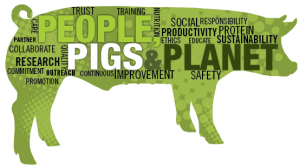Pork demand exceeded expectation last year; increase production will creates some challenges for 2015

Consumer expenditures for pork have risen 15.7% since 2009, surpassing the National Pork Board’s (NPB) aggressive goal of 10% growth.
Moreover, the total pork volume available in U.S. multiple by the average of the U.S. Dept. of Agriculture retail pork price or pork expenditure climbed by 7.6% in 2014 compared to the previous year.
“The pork expenditure results offer solid insight into what we view as a consistently growing consumer demand for pork,” said Ceci Snyder, vice president of domestic marketing for the Pork Checkoff. “Despite record-high pork prices, demand for pork has increased.”

Steve Myers, president of Paragon Economics, attributed the growth in pork demand to the National Pork Board’s focus to capitalize on food trends such as the rise of foodies and a growing passion for protein.
“The last two years have been outstanding for pork demand,” said Myers. “We haven’t moved demand upward by this magnitude since the 1990s.”
Last year, the NPB has centered its message on pork’s inspiration as a menu item, which has resonated well with consumers.
Still, the pork supply is expected to increase this year, especially as the outbreaks of porcine epidemic diarrhea virus (PEDv) cases have been relatively mild thus far.
At the end of 2014, the total U.S. pig inventory rose 2% to 66.1 million head over the previous year, marking a solid rebound.
Dale Norton, NPB president, noted that an increase in pork supplies may require adjusting the Pork Checkoff’s marketing plan.
Furthermore, Snyder told Feestuffs that the increase supply will be a challenge for both the domestic and international markets this year.
“As we head into a year of higher supplies, we need to constantly remind consumers of pork’ unique combination of flavor and versatility,” added Snyder.
More Americans are searching for new flavors to serve at the dining table with a growing interest in ethnic cuisines.
Snyder explained that recent research showed that the traditional meal of porkchop and potatoes is not as common these days.
However, pork’s versatility makes it desired protein choice as consumers seek for fresh dining adventures.
Meanwhile, a recent survey showed great optimism among U.S. pork producers, overall.
Since 2002, the NPB has conducted annual pork producer survey to gauge the general attitude of pig farming, insight to the conditions of the industry and their support of the Pork Checkoff program.
Over 89% of the pork producers support the checkoff, climbing 2% from last year for the fifth consecutive year in row. More importantly, the number of producers opposing the checkoff shrunk to its lowest level of 5%.
Pork producers participating in the survey said the most important thing the checkoff can do is educate the consumer about pork.
“Educating consumers about the safety of pork is a shift from previous years’ results when top-of-mind desires were focused and foremost on advertising and marketing pork,” said Norton. “This change stems from the increasing conversation that people are having about food production.”
For the most part pork producers (83%) believe the industry is heading in the right direction and rated managing hog health and disease was the leading production challenge.
About the Author(s)
You May Also Like


.png?width=300&auto=webp&quality=80&disable=upscale)
